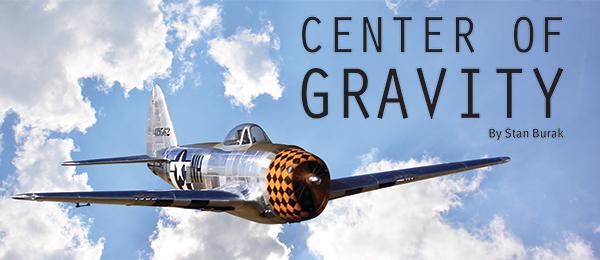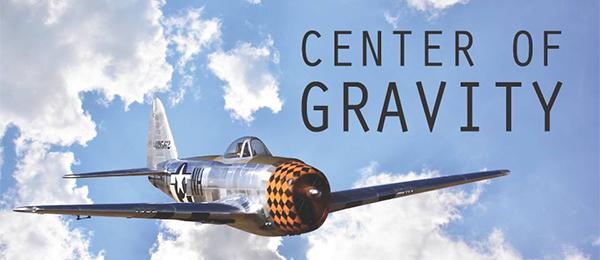How to determine your CG
By Stan Burak
As seen in the February 2014 issue of Model Aviation.
Dealing with our aircraft’s center of gravity on our RC models is taken for granted. I want to make it simple and useable to get the flying qualities we want. I have been in aviation for all of my life, and for full-scale aircraft the CG is one of the most important things to check. I have flown aircraft with forward CG and aft CG. In the 1960s I flew a Cessna 182, similar to the 172, but with a larger engine, resulting in a forward CG. Pilots had to make sure to get the nose up before running out of elevator during the flare to keep from planting the nose gear.
The elevator feel was heavy. If you did hit hard on the nose gear—we called that a $1,500 landing—which was the cost to repair the wrinkled firewall. I flew my original-design pusher with an aft CG at roughly 3% forward of the neutral point. The neutral point definition is that CG location for which there is no stability. The stick had practically no elevator feel.
In an RC airplane, we have only the feel of the transmitter and the flying quality. We can change the CG to get the quality we want without using a lot of exponential.
Most airfoils have an aerodynamic center at roughly 25% of the mean aerodynamic chord (MAC), so that is our reference point. The MAC of a rectangular wing is the chord length, and calculated for a tapered wing, but the average chord length is good enough for us. So from this 25% chord, the CG going forward is good and makes flying easier and stable.
Going aft with the CG makes the aircraft unstable and harder to fly without exponential; however, this is generally preferred for more aerobatic or 3-D flight. If you go back far enough to hit the neutral point, good luck. You’ve probably lost your aircraft! Fighters use computers to fly aft of the neutral point; humans can’t do it.
The neutral point is calculated and proven in flight or in a wind tunnel. For light aircraft certification, the aircraft aft CG is at least 5% ahead of the neutral point. I flew my tail-heavy pusher roughly 3% forward of this, resulting in no stick feel and it was sensitive.
I had a Stinger 120 that I nearly lost because of an aft CG. Plans show the CG range of 28% to 33% and I was at 33%. It was all I could do to get it back in one piece. My Giant Stinger plans show the CG of 30% to 33% and I fly it at 25%. The full-scale Reno F1 racer rules state a CG of 8% to 25%. Note that Reno racers have small horizontal tails.
What controls this and how can we change it? It’s the horizontal tail size! The larger the area of the horizontal stabilizer, the more forward and aft CG at which you can be safe. Increasing the horizontal tail moment arm (Lh), like sailplanes, will also move the neutral point aft.
The horizontal area is called the tail volume and boils down to a relative number. It is not hard to calculate this volume and another formula tells us what the most aft useable CG is. I have combined them to save some math and make it easy. The following chart gives us the safe aft CG for the horizontal volume (Vh).
CG is important to the enjoyment of flying our aircraft. If your CG is between 20% and 25%, you should be good. Forward or aft of this range is not so good and aft of 30% could end your day of flying!
The last thing you should do is mount the batteries to achieve the CG you want. In my pusher, a tail-heavy aircraft, I mounted the battery and some lead in the nose. When I designed structure on the Ted Smith Aerostar, last built by Piper, I designed the battery box in the aft side of the baggage compartment. The compartment is at the wing’s TE.
With people and engines forward of the CG, the aircraft is nose heavy and two batteries were mounted in the tail cone aft of the horizontal stabilizer! It is typical to locate the battery last in light aircraft. You can also add some horizontal stabilizer span to your aircraft, increasing the horizontal area, to move the neutral point. You have time and money in your aircraft, now finish your aircraft to fly the way you want.
—Stan Burak |
[email protected]
Sources:
R/C Model Aircraft Design Andy Lennon, author
Light Airplane Design
L. Pazmany, author
Design for Flying David B. Thurston, author
Model Aircraft Aerodynamics Martin Simons, author
Airplane Performance Stability and Control Courtland Perkins and Robert Hage, authors
How to DETERMINE YOUR CG















Comments
Formula
The formula should have parentheses like so: Vh = (Sh x Lh) / (Sw x c). Of course, there is no perfect CG location. Like expo, dual rates, etc., it still comes down to personal preference. Start a little nose-heavy and slowly move it back.
CG
Very well written, and easy to understand. Helpful, and readily applied.
I take his final recommendation to be that you install batteries last to set your CG. I hope that is what he meant.
Center of Gravity
Most models I have built had the CG represented as a range of numbers (forward, center and rearward). When balancing a model, at what point in this range should the model be balanced?
Biplanes
Everyone writes these articles for single wing planes. What about Biplanes?
CG on a biplane
I have a tiger moth that I’m having difficulty getting the proper CG due to the fact it’s a biplane what’s the best way to go about it
Neutral point
Can this comment be better explained…???
The neutral point definition is that CG location for which there is no stability. The stick had practically no elevator feel.
What is the neutral point…????
Please let me know.
Thanks LARRY [email protected]
Add new comment